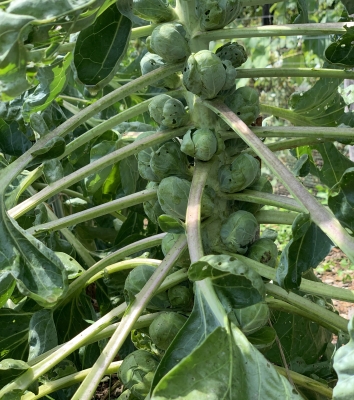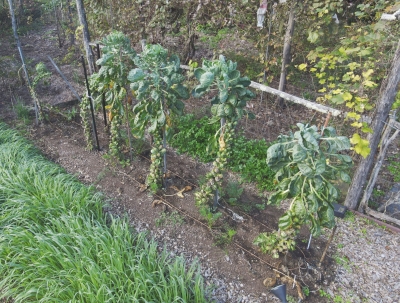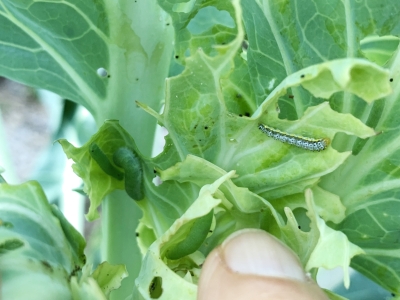WHAT I LEARNED ABOUT BRUSSELS SPROUTS
Sprout Success
Years ago, a friend referred to Brussels sprouts as “little green balls of death;” that never exactly increased the gustatory appeal of this vegetable for me. The same could be said for “a little boiled to death,” a too common way of preparing the vegetable, and perhaps that’s what the friend had actually said.
Still, I’m always up for a horticultural challenge, even if I had never had success with Brussels sprouts. What does “lack of success” mean with Brussels sprouts? Dime-size sprouts.
Sit tight. This season my Brussels sprouts are a roaring success, and I’m going to impart to you what I learned about growing this sometimes maligned vegetable. Or, at least, what I did differently this year, which was a few things, so I’m not sure whether one or more of them was responsible for my achievement. It could even have been the weather, which I had no hand in.
Brussels sprouts is a very long season vegetable, so seeds need to be sown in spring for a fall harvest. Check. I planted mine back indoors in March for transplanting in May. They could have been sown a little later, at some sacrifice of yield.
A big difference in what I did this year was that the seeds that I sowed were those of a new variety, Catskill. Although a new variety for me, Catskill is actually an old variety, first introduced in 1941 by Arthur White, of Arkport, New York. It’s billed as yielding especially large sprouts (yes) on compact stalks (nope). In previous years I grew Gustus, Hestia, and Prince Marvel, and all were duds for me.
The Catskill mountains are only an hour’s drive away from my farmden, which perhaps explains my success with the same-named variety. But, as they often say (quietly) in advertising, “your results may differ.” My suggestion is to try a few varieties until you find one that does well wherever you garden or farmden.
Brussels sprouts requires a rich, near neutral soil high in organic matter. Check. My Brussels sprouts beds have always received, as do my other vegetable beds, an annual dressing of a one-inch depth of compost. Decomposition of compost enriches the soil with a variety of nutrients, including nitrogen.
Still, another big difference in what I did this year was to give my plants an extra oomph with, in addition to the compost, a sprinkling (1 pound per 100 square feet) of soybean meal, an organic source of nitrogen.
In anticipation or hope of large plants, each Brussels sprouts plant was afforded plenty of elbow room this year, with plants two-and-a-half feet apart down the middle of the three-foot-wide bed. They were flanked on each side by a single row of early carrots which, I figured, would be harvested and out of the way by the time the Brussels sprouts plants were spreading their wings (leaves).
My previous efforts with Brussels sprouts always resulted in three-foot-high plants that, early in their youth, flopped to the ground. Only after a plant’s supine stem had created a firm base would the end of its growing stem curve more or less upward, according to original plan. That youthful waywardness wasted and muddied lowermost sprouts, with the sprawling plant demanding even more space, which was a problem in my intensively-planted garden.
This year each plant had the companionship of a sturdy metal pole right from the get-go. Loops of string around the stalks and the stakes kept up with the plants’ upward mobility.
Pest Alert
Finally, and very important, is pest control, specifically of any one of the few leaf-eating caterpillars, colloquially called cabbage worms, which are the offspring of of those cheery, white moths that flutter among the plants on sunny days. The caterpillars also attack broccoli, cabbage, and cauliflower, all relatives in the cabbage family (Brassicaceae).
A very effective and nontoxic to most creatures (including to you and to me) control is spraying with Bacillus thuringienses, a naturally-occurring bacterium extracted from the soil. This material is more easily remembered under the name Bt, packaged up under such commercial names as Thuricide, Dipel, and Monterey B.t.
I checked the plants frequently through the growing season, at first just crushing any caterpillars I found and, only when the damage was getting severe, resorting to the spray. Cabbageworms, like any pest, can develop resistance to most pesticides, more likely the more that is used.
GMO. No
As an aside, that potential resistance of a pest to Bt is a problem with crops developed as genetically modified organisms wit Bt toxins. Almost all commercial corn and cotton have been genetically engineered in this way; the genetic material has also been incorporated into cotton, potato, rice, eggplant, canola, tomato, broccoli, collards, chickpea, spinach, soybean, tobacco, and cauliflower.
The problem arises because a field of plants expressing the Bt toxins is akin to that whole field being sprayed with Bt all season long. There is evidence of the development of resistance to Bt by insect pests of the genetically modified crop plants.


I grew beautiful leaved Brussels plants , but by the beginning of October only a couple had minuscule sprouts. Some had none. I fed intermittently with fish emulsion. I am very frustrated as it is the second year of my efforts. Any other suggestions?
Do what I did: timing for planting, pest control, fertilization, and staking early on.
Have you tried lopping off the top 1″ of the plant in mid to late August? Lee did not mention this so I presume he does not use this technique, but when I apply it my sprouts are much larger and tighter.
I have tried topping Brussels sprouts many times, except I’ve done it on Sept. 1st. I never saw any benefit.
That may be too late to top them. When I was late in topping mine I experienced diminished quality. I always did it in mid to late August (in Northwest NJ) with mid August yielding the best results. Experiment.
It’s a thought. I might give it a try.
I had no Brussel sprouts on any of my plants this year! I’ve never had that happen before.
Mislabelled seedling, plant started too late, not enough sun, not enough fertility or water??? Did the plants grow well? How tal?
Steam the brussels until fork tender, don’t boil. Meanwhile, in a small pan sizzle butter until it turns brown (browned butter). Cut each brussel sprout in half, then drizzle the butter over the bowl. You can’t believe how delicious!
That does sound delicious — and simple!
I used to grow great Brussels Sprouts. The variety I grew after trialing many was Oliver. It always performed stupendously. Oliver seeds became unavailable, and I have never found any variety that performed well since (including Catskill). Anyone have any suggestions (I am in zone 6b in NW NJ) or know of any plans to reintroduce Oliver?
As I wrote, “Your results may differ.” I once tried Olive but it did not do well for me. Then again, If I did everything I did this year for the Brussels sprouts, and perhaps depending on the weather, Oliver or any other variety might also have done as well as Catskill.
Hi! I have tried on numerous occasions to grow BS and had little to no
success. One year a had a decent yield. But I love them, and would try again
using your techniques. You did not list the source of your Catskill BS seed.
Where did you get it?
I have learned so much from you that I feel I should list you on my CV at this point. Thanks for sharing so generously of your knowledge.
I believe I cot the seeds from J. L. Hudson seeds, in California, but a number of sources are listed on the web.
Thanks for the kind words.
At the donation garden where I volunteer, we cover all our brassicas and squashes with protek net. Expensive but effective. We produce beautiful produce.
Yes, I’ve seen gardens where that was the approach, and it surely works. Of course, it would be harder to protect 43-foot-tall brussels sprouts plants.
What, if anything are you doing about jumping worms?
Nothing. I saw a little evidence of them here on the farmden about 15 years ago, and then they disappeared for no apparent reason.
I wish mine would disappear but no such luck – I hear they die in winter but leave little round eggs for the next season. My friends think I’m obsessed and that this is all a fabrication but I do see their leavings (castings?) and the soil does change in appearance. You’ve probably read this all points alert:
European nightcrawlers are now being displaced by the destructive Asian jumping worms. There are actually at least three species: Amynthas agrestis, Amynthas tokioensis, and Metophire hilgendorfi that co-occur.
Asian jumping worms devour organic matter more rapidly than their European counterparts, stripping the forest of the layer critical for seedlings and wildflowers. Jumping worms grow twice as fast, reproduce more quickly, and can infest soils at high densities.
In areas of heavy infestation, native plants, soil invertebrates, salamanders, birds, and other animals may decline. These invasive worms can severely damage the roots of plants in nurseries, gardens, forests, and turf. They, along with other invasive worms, can also help spread invasive plant species by disturbing the soil.
Asian jumping worms are an annual species; the adults die after the first freeze. But the cocoons, which are about the size of a mustard seed, will survive the winter and hatch when temperatures reach 50°F for a consistent period. One worm can produce many cocoons without mating.
Because they are more aggressive and their populations can grow faster than the common European species, they may out-compete existing worm populations. Cocoons are very small and dirt-colored, so they are nearly impossible to spot with your own eyes. Cocoons can be spread easily in potted plants, on landscaping equipment, mulch, tire treads, and even hiking boots.
Should I throw out what’s in my compost bin? I see a few wigglies there!
Good question at the end. As far as I can tell, there’s no way to get rid of them. But, how about spreading the compost and then warming the soil in winter with black plastic for awhile. Then, while outdoor temperatures are still cold, remove the plastic to kill the hatched worms. Just a thought.
Great info! Thanks for pointing out the differences in BT organic application vs BT GMOs. I’ve been growing kale all season and amazingly I’ve had zero cabbage worm issues. I’ve seen plenty of white butterflies flying around, but the spiders, hornets & wasps must be doing the trick! The larvae never get a chance. 🙂
Good Lord, the cabbage worms decimated my red and White Russian kale, but the stiff, thicker leaved variety (?) did wonderfully, and is still doing great up here in zone 4b.
My “Scotch Blue Curled Kale” also seems pretty resistant.
I love Scotch Blue Curled Kale. It is fantastic for juicing, which I do on a regular basis. But I also find that it is robust and sails through most
challenges with pests and weird weather. I save my own seed, of course.
No comparison to purchased commercial seed. It comes up like a lawn.
I wonder if the texture is just more challenging? My cabbages took an awful hit this year from loopers. I gave up and fed the sad remnants to the chickens. What type of cabbage do you grow? Any that are particularly tough and resilient? I am in Maine.
I grow Bartolo cabbage ofr its good storage capability and Early Jersey Wakefiled for its flavor.
Ive notice this as well. No larvae on my kale. The collards were another story..
I have always had good luck with Hestia up here in the Adk’s zone 4b. I could not find the seed this year so I tried Long Island and Speedia (which had replaced Hestia in Fedco). The LI was a bust, but Speedia did quite well. I , too, had much better luck with spacing them about 2 feet apart. Next year even further. And I support them as well. Caterpillars decimated my broccoli and cabbages but the slugs annoyed the BS to a degree. I need to stop mulching everything because I have too tooo much trouble with slugs.
I too mulch a lot in my gardens using pruned cut-up branches of
bushes and pulled weeds, leaves, humus etc.
I have had less slugs this year than in years past, but have some.
I am going to put out a dish of beer for the slugs to
climb into and not crawl out of.
My broccoli plants have a lot of damage from Cabbage Worms.
The slugs eat larger sections of the leaves than do small CWs.
Some of the broccoli leaves look like lace due to the scavenging
of the cabbage worms.
A hive of bald faced hornets that set up shop near my garden kept the “cabbage worm” damage to a minimum for most of the season, but eventually I started to see some damage to harvestable parts of the plants so I did one spraying of BT in late September. Within a couple days of that the hornets abandoned their nest. Did eating the sprayed cabbage worms kill the hornet larva too?
Probably not because the toxin in Bt is specific against Lepidoptera “worms” such as cabbage worm. How do you know that that the hornets were controlling the caabage worms?
Hi Lee –
This is not at all about Brussels sprouts, which I love to eat but never grew. It’s that potted kumquat that you inspired me to cut back/thin. It looks great, but never flowered, no fruits.
Any ideas?
Cheers,
Barbara Lubell
Time? Patience? Sun?
Hmmm. Looks healthy. Don’t think I’ll prune it this year, yes?
I refrained from pruning a Datura brugsmansia cluster – it got so huge, I couldn’t bring it outside this year, and for the first time in 35 years, the thing is flowering!
A friend of mine wanted to know if I wanted her Meyer lemon tree. Not that I have room for another huge plant! The leaves looked kind of pale, so I put 2 quarts of fish emulsion in. It has 2 little green fruits on it. Looks old & gnarly.
Happy Autumn!
Barbara
I’m late to the party but had to comment that while I’m in Central Texas and can’t get Brussels Sprouts to make it through our summers to the fall, I grow them for the leaves! Same flavor and they saute faster!
I would imagine that far south that the way to grow Brussels sprouts would be to plant in mid to late summer for a late fall, winter, and early spring harvest. No?
That does make sense! By late summer I’m usually tired of everything I’ll have to try it. Either way I do love the leaves.